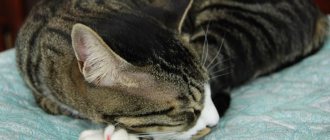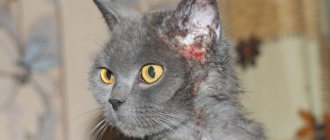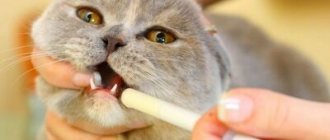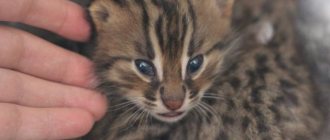A louse is a specific human parasite that feeds on human blood and does not live on anyone else. People cannot become infected with these insects from cats or dogs. But domestic animals also have parasites, which are called lice because of their similarity to the human head louse in appearance and lifestyle.
Lice in cats are called lice eaters. These insects attack the fur and skin of cats and cause a lot of pain. They differ from fleas: they cannot jump and are generally inactive. They live only on cats; if they get on other animals or humans, they die. Likewise, human lice do not live on cats.
How are cat lice different from human lice?
The main difference between lice is their diet. The human louse feeds on blood, while the cat louse feeds on particles of skin and fur. She chews off pieces of the animal's skin with her sharp jaws, leaving wounds that itch and bother the cat. The louse does not purposefully drink blood, but it can also feed on it from the surface of the skin if it encounters a wound along the way. It cannot pierce the skin like a human louse.
Lice that live on cats are not dangerous to humans. But these parasites carry eggs of different types of worms, so they can be dangerous for children and people with low immunity. If you pet an infected animal and then do not wash your hands, you can simply introduce the pests into your mouth.
Causes of disease in animals
Blood-sucking insects most often attack young animals. They are usually located on the neck, front of the chest, and back. These parasites multiply quickly. Their numerous bites cause intense itching - this occurs due to an allergic reaction to the saliva of lice.
Their appearance may be a consequence of infection, as well as the presence of worms in the animal:
- Lice can be transmitted through tapeworm larvae. The parasite swallows a tapeworm that has hatched from an egg.
- A cat can swallow an infected louse. Over time, the tapeworm will begin to develop in the intestines.
- There is a danger that when mating cats reach puberty, they are at risk of becoming infected with eggs that look like white cucumber seeds.
Differences between fleas and lice
Unlike fleas, the largest lice infestations occur in the fall or winter.
They feed mainly on the epidermis, wool, and drink blood.
An infected cat needs to be treated not only for lice, but also for worms, because these parasites are interrelated.
What do lice look like on a cat?
Cat lice are similar to human lice. They have an oblong body with a triangular head and powerful mouthparts. Body light yellow. The paws are short, underdeveloped, adapted for moving along a cat's fur. This is one of the main differences between fleas and lice - fleas have powerful hind legs that allow them to jump.
In their development, lice eaters do not pass through the pupa and nymph stages. Like human lice, they lay eggs called nits. The nits hatch into individuals similar to adults, but smaller in size. The life cycle of the lice eater is up to 4 weeks. During this time, the female can lay 60–70 eggs. Nits are oblong, hard, and are glued to the animal’s fur with thick mucus. They are quite noticeable.
Danger to humans
Many pet owners are concerned about whether cat lice can be transmitted to people and spread among family members. Therefore, first things first.
Do people get bitten?
The mouthparts of cat lice are not capable of biting through skin. Therefore, this type of parasite does not pose a danger to humans.
Is it transmitted from cat to person?
Cat lice do not spread to people because their paws are unable to stay in human hair and skin. In addition, without a power source, they quickly die. Therefore, a person cannot become infected with lice from a cat.
Are human lice transmitted to cats?
Similar to the previous one, we can answer the question: are lice transmitted from humans to cats?
Human lice are able to fully develop and reproduce only at a certain body temperature. They also feed purely on human blood and are not infectious to cats.
Where do cat lice come from?
Lice eaters can appear in any cat except hairless ones. Long-haired pets are especially affected by them. There is a greater risk of contracting lice from outdoor cats, but indoor cats can also become infected.
Routes of infection:
- contact with another animal that carries lice on the street or staircase;
- in a veterinary clinic, grooming salon;
- the owner may bring in cat lice on clothes and shoes.
Lice in cats are not very mobile, but if necessary, they can travel some distance not only along fur, but also on other surfaces. On an animal, they prefer to settle in areas with the most delicate skin and short, soft hair - on the head, back of the head, and near the tail.
Determining the type of pest
Jumping insects can be easily identified by their characteristic dark brown hue and dense body, which is almost impossible to crush. You will notice how such a parasite jumps, quickly disappearing from your view.
Flea species are classified according to the type of prey they parasitize. The most dangerous are rats, which carry a huge number of dangerous diseases, including plague. The peculiarity is that fleas do not disdain other victims, so the feline type can bite people without any problems.
If you notice that your cat is itching, you should immediately determine the type of parasitic disease. Most often, fleas and lice live in a kind of tandem, so it is quite difficult to distinguish insects on fur. The length of the sucker does not exceed 3 mm, and lice can grow up to 5 mm. The lifespan of an adult from the moment it emerges from a nit is 40 days. During such a period of time, the pest manages to cause enormous harm to the animal and lay many new eggs. If you don’t know what lice look like, then focus on the size of the insect and its proximity to the surface of the epithelium.
The most obvious sign of a pest on an animal is nits. This is the name given to the eggs that lice lay. From the moment of birth until death, insects are in the fur of their victim and actively reproduce. A special adhesive substance tightly attaches the nit in the shell to the hair, so it will be especially difficult to even tear it off with your nails. You don’t even need to look at photographs to see what lice and nits look like. You will immediately notice parasite eggs on your pet's fur during routine grooming.
Small nits will be much more noticeable than lice on cats. With a high degree of infestation and a large number of eggs laid, it will look as if the pet’s fur is sprinkled with grains. Lice are especially mobile and try to spend all their time close to the epithelium and out of sight of humans. At first you may think that your cat has dandruff, but then you will see unusual oblong-shaped capsules that do not exceed 1 mm in size.
Symptoms of infection
Lice in cats often appear simultaneously with fleas, but they can infect a pet on their own. The following signs may indicate that a cat has pediculosis, or more precisely siphunculatosis (this is what infestation with lice eaters is called):
- severe itching - lice bite off pieces of skin, constantly injure the cat and cause it to itch continuously;
- the appearance of bleeding wounds, abrasions, scratches - both from bites and from scratching;
- shedding - the animal begins to shed its fur, and this is not similar to seasonal shedding: bald spots appear in certain places;
- upon careful examination, you can see accumulations of insects, their excrement, remains of shells, and nits;
- anxiety - the cat behaves unnaturally, constantly itches, rubs itself on its legs and furniture, sleeps poorly, etc.
Preventive measures
To prevent the massive spread of parasites and maintain the health of your pet, it is necessary to adhere to certain preventive measures.
Wool inspection
Basic recommendations:
- Regularly inspect your cat’s fur and skin for lice and fleas;
- carry out seasonal treatment with special means;
- provide a balanced diet to strengthen the immune system;
- treat not only the animal, but also its belongings with special preparations;
- Treat all scratches and wounds promptly.
How dangerous are lice for cats?
In addition to debilitating itching, lice in cats can cause the following problems:
- hair loss up to total baldness;
- infection of wounds from vinegar leads to the development of dermatitis and eczema;
- in particularly advanced cases, infections from wounds enter the bloodstream and can cause more complex diseases;
- lice eaters are carriers of worm eggs.
If lice are not removed, this can develop into other diseases and ultimately lead to exhaustion and death of the animal.
Getting rid of fleas in pregnant, lactating cats and kittens
Naturally, a pregnant four-legged pet should be treated as carefully as a pregnant woman. Gestating cats are sensitive to various components and should not be treated with toxic or harmful substances against pests. It is best to consult a veterinarian before treatment.
Products for a pregnant, lactating cat, or kitten may include:
- Special shampoos, they are as harmless and effective as possible;
- Non-toxic and gentle sprays;
- Special oils that are suitable for pregnant cats or kittens;
- For pregnant cats or their children, you can try traditional methods of treating parasites.
In any case, you need to consult a veterinarian; he will select the most harmless and suitable remedy for your pet and her babies:
- Advantage drops. This product will help rid a pregnant cat or kitten of parasites in its fur without harm to its health. The cost ranges from 150 to 200 rubles.
- Fiprist spot-on, costing 150 rubles and more, will help to harmlessly rid a pregnant cat of pests.
- Frontline will help your cat get rid of harmful insects in her fur. They cost approximately 200 rubles.
How to get rid of lice from a cat
If you are not sure whether your pet has lice, contact your veterinarian. A specialist will accurately determine the type of parasite during a visual inspection. It can also make a differential diagnosis by taking a scraping from the animal's skin. The veterinarian will recommend a product to kill parasites, as well as a drug to treat skin problems if the cat already has them due to lice.
Folk remedies
You can use folk remedies to treat your cat for lice. This could include swimming in salt water. A kilogram of salt is diluted in 10 liters of water. The cat is bathed in this bath so that the salt water saturates the fur and is absorbed into the skin. The method should not be used if there are wounds, since salt irritates them very much. The solution is not washed off after the bath; the animal is thoroughly combed to remove parasites and nits.
Another way is to treat the animal’s body with a decoction of wormwood (20 grams of dry herb per half liter of water, boil for 20 minutes) or infusion of garlic (6 cloves per 0.6 liter, leave for 12 hours).
Shampoo
Special insecticidal products for animals are produced in the form of shampoos. Products that are used against fleas, ticks and other pests are effective against lice. They all operate on the same principle: they paralyze insects, causing their death. Shampoo is the most gentle remedy for lice in cats. You need to bathe the animal with it and then comb it to remove parasites from the fur. Sometimes one procedure is enough, but it is worth repeating the treatment after a few days. Shampoo may contain softening and healing substances, and components that care for the coat.
Many shampoos can be used for kittens from 4, 6 or 10 months of age. For kittens younger than this age, there is only one way to fight it - combing. But their fur is thin, easily visible, and the affected area is not too large, so it can be dealt with in several approaches.
Spray and drops
In serious cases of cat infestation with lice and when bathing with shampoo is not possible, insecticides are used in the form of a spray or drops. They are applied to the withers. These products act very quickly and retain their protective effect for several weeks or even months. The main thing is to prevent the cat from licking this product from the fur, but doing this from the withers is very difficult. It is better to carry out processing outdoors. The animal is not bathed for several days before and several days after. After 2 weeks you can re-treat.
Collars
To prevent lice infestation, it is recommended to purchase special collars for free-ranging animals. They can even be used on kittens from birth. But it is worth considering that the pungent odor and toxic insecticides in the composition can cause an allergic reaction.
Prevention
Preventing lice in cats consists of the following steps:
- Using a flea collar.
- Keeping the cat in recommended conditions.
- Complete nutrition with factory-prepared feed.
- High-level security system support. The use of immunocorrectors: Gamavit, Maksidin, Immunofan, etc.
- Treatment of cats' habitats with insecticides.
Healthy cats that live in a clean environment and eat nutritious food have good skin condition. The absence of defects reduces the access of insects to nutrients and prevents their reproduction. The skin is not injured and resists the aggression of fungi and fungi. If fellinologists regularly destroy parasitic insects, the cat remains healthy and free from uninvited guests.
We invite you to join our Zen channel and group on VKontakte or Odnoklassniki, where new articles for pet owners are published.
Similar articles:
- Ringworm Caution: What Pet Owners Need to Know
- Why are cats overweight?
- Nephritis in cats
Which drugs to choose
The market for veterinary drugs is saturated with drugs against cat lice. You can choose based on price, manufacturer, shape, composition. Products based on cypermethrin and permethrin are effective. You can buy, for example, Ectometrin from Medilis. Ectometrin is an insectoacaricidal (antiparasitic) agent intended to combat lice, fleas, lice eaters, lice beetles, skin beetles, flies, sarcoptic, ixodid, and chicken mites parasitic on animals (dogs, cats, fur-bearing animals, cattle, pigs, horses, goats , sheep) and poultry (chickens, geese, ducks), as well as for disinsection and decontamination of livestock buildings. The main thing when choosing and using any product is to strictly adhere to the instructions. And on the website you can always use the Ectometrin “working solution” calculator.
Flea removal products
Modern owners of domestic cats are lucky, because they will be able to choose the product that is best suited for their pet or pet. Fortunately, today there are quite a lot of products in the range of products that treat furry pets from unexpected residents in wool.
Collars
As a rule, such a device for getting rid of fleas is worn on cats and kittens that go for walks outside. But, if an animal that is constantly at home has enemies, then you can use the collar for them too.
Advantages of the collar:
- It is impregnated with special oils that have a detrimental effect on parasites;
- Fleas that visit the device directly die;
- Those who did not manage to get to the collar run away from their temporary “home”;
- The substance with which the collar is impregnated is protection not only from fleas, but also from ticks and other insects that can harm the health and peace of mind of your beloved pet.
- In addition to helping to rid the cat of nits, the collar also helps eliminate unpleasant fur odor.
Among the collars you can choose from:
- The Beaphar collar costs approximately 200 rubles. Helps get rid of fleas for 5 months.
- The SOS anti-parasite collar costs about 300 rubles and will help remove harmful inhabitants of cat fur as quickly and effectively as possible.
- The Multix collar will rid your pet of biting pests for 2 months in advance, the cost is about 350 rubles.
Flea drops
Another fairly popular means for removing fleas from furry pets are drops. This product is filled with special substances and components that poison unwanted guests in the fur of your cat.
The product should be applied with caution. It is important that the drops do not get on the mucous membrane of the nose, mouth or eyes. To avoid such precedents, you need to drip the product onto the withers and back of the animal, where it cannot reach.
You can choose from the following:
- Celandine. These drops will help remove unwanted residents from your pet’s fur as quickly as possible and protect them from visiting them again for 2 months. The cost of the drug is approximately 200 rubles.
- Inspector drops will help quickly relieve your furry pet from suffering. The cost is 300 rubles.
- BlokhNet max cost only about 60 rubles. The effect from them is as high as from expensive drugs.
Sprays
Flea spray is very effective and often used. Its effect on parasites has been appreciated by many owners of furry cats and seals whose fur has harmful fleas.
Spray benefits:
- Its impact is almost immediate;
- One use is enough to completely get rid of parasites;
- This product can be used to treat not only the animal, but also the room in which it resides;
- The spray is easily washed off from the animal's fur, which makes the fate of the owners easier;
- The cost of the spray is as affordable as other products.
Pay attention to the following tools:
- This spray will help get rid of parasites in a short period of time. The cost of the drug is affordable and is no more than 180 rubles.
- Delix spray will save the animal from problems associated with nits. The cost is approximately 140 rubles.
- Celandine spray will effectively and quickly rid your animal of fleas in its fur. The cost is 180 rubles.
Shampoos
This product is quite effective in fighting fleas. It has special substances that repel and neutralize parasites in the animal’s fur and skin. The cat easily tolerates such flea removal, as it is immediately washed off from her.
The only thing that can be noted as disadvantages of flea shampoos is:
- Not an immediate effect, requires repeated use;
- Not all cats will agree to this method of getting rid of fleas, since many members of the feline family do not really like to bathe;
- Some shampoos do not have a very pleasant smell, so you should definitely smell the product before purchasing.
You can give preference to the following drugs:
- Phytoelite is an affordable, about 60 rubles, and highly effective product.
- BIO-GROOM shampoo costs approximately 1000 rubles. Helps get rid of parasites in an animal’s fur as quickly and easily as possible.
- A badger costs about 30 rubles. It will help you quickly and easily save your animal from flea bites.
Injections and pills
In the case of neglected fleas, the animal can damage its skin so much by scratching that surface treatments can cause discomfort and cause discomfort to the cat. In such cases, drug treatments such as injections or tablets are used.
Situations in which it is better to give preference to this particular remedy:
- The cat has wounds on the skin;
- Tried external remedies did not give the expected result;
- Parasites have settled in the pet’s fur and skin for a long time and caused bodily harm;
- As recommended by a veterinarian.
You can choose the following drugs:
- Comfortis tablets cost approximately 4,000 rubles. The product will help not only save the cat from fleas that have already settled, but also protect against their reappearance.
- Bravekta tablets that will help treat and prevent fleas in cats. They cost approximately 1000 rubles.
- NexGard tablets will effectively help protect the animal from the effects of parasites in the fur. Costs approximately 100 rubles.











